The Largest Gold Nuggets Ever Discovered
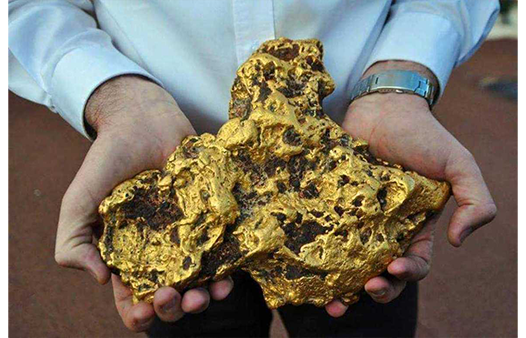
What is Gold?
Gold, the glittery and valuable metal, has been a source of fascination, charm, and amazement for centuries. It is a symbol of wealth, power, and status. It has been prized throughout human history and is often used in jewelry, currency, and other decorative objects. Gold is typically found in its purest form as nuggets or grains in streams and riverbeds. It is also mined from quartz reefs in hard rock mines. In this article, we will explore the largest gold nuggets ever discovered, their history, and the stories behind their discovery.
What is a Gold Nugget? monster nugget
Gold nuggets are natural occurrences of gold formed as a result of geological processes deep within the earth's crust. While gold nuggets can be found all over the world, they are most commonly found in areas that were once home to ancient river deposits or in gold-rich quartz veins in mountains around the globe, from Brazil all the way to Australia.
Gold nuggets come in a variety of shapes and sizes, often ranging from pea sizes to the size of a human fist. They can be embedded in rock, iron, or more commonly, quartz. Iron and quartz can help preserve and protect gold, ensuring that it remains pure. Once gold nuggets are extracted from the earth, they typically undergo the process of smelting to separate the precious metal from any other impurities. This process can be hazardous, as the high heat and toxic chemicals used to melt the gold can be harmful to those conducting the work. However, smelting remains a critical step in separating gold from other materials.
Several refining processes are available to separate gold from other materials. One commonly used process is the electrolytic cell method, which uses an electrolytic solution to dissolve the gold and seal it in a cathode. Likewise, the aqua regia process is commonly used to extract gold from ores and other materials that contain it.
World’s Largest Gold Nugget
While gold has been found in various forms, the most awe-inspiring and truly magnificent specimens are the gold nuggets. Nuggets that are so massive and impressive that they garner attention and awe from across the world. Over the years, numerous large gold nuggets have been unearthed, each one more impressive than the last. Let's take a look at some of the world’s largest gold nuggets discovered to date.
The Welcome Stranger Nugget (1869)
One of the most significant discoveries was made in the gold-rich Ballarat region of Victoria, Australia, during the Victorian Gold Rush that began in the 1850s. English miners working underground at the Red Hill Mining Company uncovered a massive gold nugget. The nugget, known as the "Welcome Stranger," was the largest single gold specimen ever discovered. Interestingly, the miners almost mistook the nugget for a piece of iron, but upon closer inspection, they realized it was indeed a massive chunk of gold.
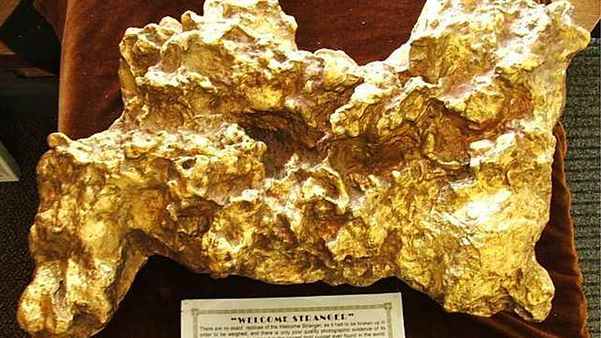
Discovery of the Nugget
The Welcome Stranger was discovered on February 5, 1869, in Moliagul, Victoria, Australia. It was found by John Deason and Richard Oates, two Cornish prospectors who were working together in the goldfields of Victoria. The two blacksmiths were using a pickaxe and a crowbar to dig for gold in a quartz reef near Moliagul, also in Victoria, Australia. They didn't initially realize the significance of their find and took the nugget to a local bank, wrapped in a blanket. The news of the discovery quickly spread, and the Welcome Stranger Nugget became a sensation. The nugget was discovered in a relatively shallow depth, only a few inches below the surface. The Welcome Stranger is classified as an alluvial gold nugget. Alluvial gold refers to gold that has been eroded and transported by water, eventually settling in riverbeds or other sedimentary deposits. This type of gold is often found close to the surface. Moliagul, the region where the Welcome Stranger was found, was known for its rich gold deposits during the Victorian gold rush.
Dimension & Size of the Nugget
The Welcome Nugget remains one of the largest gold nuggets ever found. It weighed a staggering 2,280 troy ounces, which is approximately 72 kilograms or 158.78 pounds. It measured about 24 inches (61 centimeters) in length and 12 inches (30 centimeters) in width. The nugget's horsehead-shaped form made it stand out, and it was quickly dug out of the ground using pickaxes and shovels. The discovery of the Welcome Nugget helped spark the gold rush in Ballarat, leading to a significant increase in mining activity and prosperity in the area.
After its discovery, the Welcome Stranger was quickly sold to the London Chartered Bank of Australia for a sum of £9,381, which was a significant amount of money at the time. It was then melted down, and a replica of the nugget was made for public display.
Current Location of Gold Nugget
Although there are numerous amount of replicas of the Welcome Stranger Nugget, the original nugget sadly no longer exists.
1987 Australian Nugget gold coin
The Welcome Stranger gold nugget is depicted on the Perth Mint's 1987 1 troy ounce Australian Nugget gold coin, commemorating the Australian gold rush since the mid-1800s.
Bernhardt Holtermann Nugget (1872)
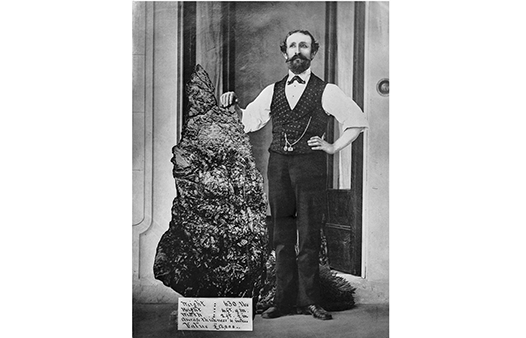
Discovery of the Nugget
German-born miner Bernhardt Holtermann's discovery of the "Mass of Gold" in New South Wales, Australia in 1872 is another interesting story. Holtermann and his partner found the enormous gold-encrusted rock while working on a quartz reef. The chunk of gold weighed in at a staggering 286 kilograms. The Bernhardt Holtermann Nugget was named after Bernhardt Holtermann, a successful miner and businessman who was involved in its discovery. It was found at the Star of Hope mine, which was owned by Holtermann and his partner, William Beyers.
The discovery of the Holtermann Nugget was significant due to its immense size and the large quantity of gold it contained. It brought attention to the rich gold deposits in the Hill End area and contributed to the gold rush fever that swept through Australia during the 19th century.
Dimension & Size of the Nugget
The Bernhardt Holtermann Nugget was discovered in 1872 in New South Wales, Australia. It was an enormous mass of gold, weighing 286 kg (630 lb) and measuring 1.5 m (4 ft 11 in) long by 0.7 m (2 ft 3 in) wide. This nugget was so large that it had to be broken into three pieces before it could be transported to the smelter. It contained an estimated 3,000 troy ounces of gold.
What sets the Holtermann Nugget apart is its distinctive feature of being embedded within a large quartz matrix. The gold can be seen branching out in intricate patterns throughout the quartz, creating a visually stunning display.
Current Location
Today, the Bernhardt Holtermann Nugget is on display at the Museum of Applied Arts & Sciences in Sydney, Australia. It is accessible to the public and can be viewed as part of the museum's permanent collection.
The Great Triangle (1942)
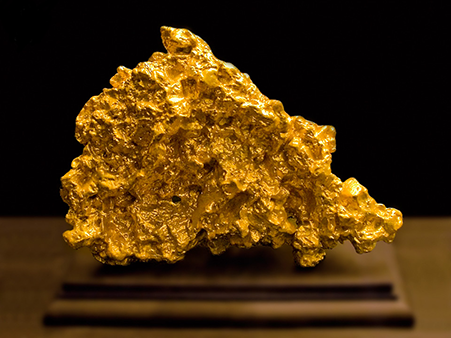
Discovery of the Nugget
The "Great Triangle" gold nugget was discovered in the Miass area of the Russian Urals mountains in 1842 by Nikofor Syutkin, a Russian prospector. It was unearthed from a depth of approximately 3.5 meters.
The discovery of the "Great Triangle" nugget in the Urals highlights the historical significance of the region as one of Russia's earliest gold mining areas. Today, Russia is the world's third-largest gold producer, with extensive gold mining operations, particularly in the eastern part of the country. In 2016, Russia's gold mining production output reached 250 tonnes.
Dimension & Size of the Nugget
This impressive nugget has a gross weight of 36.2 kilograms. With a gold assay of 91%, it contains a fine gold content of 32.94 kilograms or 1059 troy ounces. The dimensions of the nugget are approximately 31 centimeters by 27.5 centimeters by 8 centimeters, and its distinctive triangular shape gave it the name "Great Triangle."
Current Location of Gold Nugget
The "Great Triangle" gold nugget is owned by the Russian State and is part of the collection of the Diamond Fund, which is housed in the Kremlin in Moscow. The Diamond Fund is a permanent exhibition that showcases the crown jewels, precious stones, gold, and platinum nuggets belonging to the Russian state.
Hand of Faith (1980)
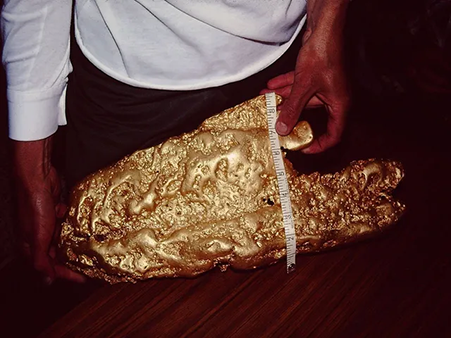
Discovery of the Nugget
The Hand of Faith was discovered in 1980 by Kevin Hillier, an Australian gold prospector. It was found near Kingower, Victoria, Australia, using a metal detector. The discovery site was not far from the location of the original gold rush in Victoria during the 19th century.
After its discovery, the Hand of Faith was initially showcased at the "Golden Nugget Casino Hotel" in Las Vegas, Nevada, where it gained widespread attention. In 1981, the nugget was sold to the casino for approximately one million dollars.
Dimension & Size of the Nugget
The Hand of Faith is recognized as the largest gold nugget discovered using a metal detector. It weighed a remarkable 2,218 troy ounces (approximately 61.01 kilograms or 134.1 pounds). The nugget's size is substantial, measuring about 10 inches (25 centimeters) in length.
The Hand of Faith is an alluvial gold nugget, formed through natural erosion and transported by water. It features a textured surface with visible crevices and indentations, typical of nuggets found in riverbeds. The name "Hand of Faith" originates from its unique resemblance to a hand reaching out.
Current Location of Gold Nugget
The Hand of Faith is currently on public display at the "Golden Nugget Hotel and Casino" in Las Vegas. Visitors have the opportunity to witness this iconic gold nugget firsthand, marveling at its impressive size and the incredible story behind its discovery.
1987 Australian Nugget gold coin
Commemorating the Australian gold rush since the mid-1800s, The Hand of Faith gold nugget is depicted on the Perth Mint's 1987 1/2 troy ounce Australian Nugget gold coin.
Pepita Canaã Nugget (1983)
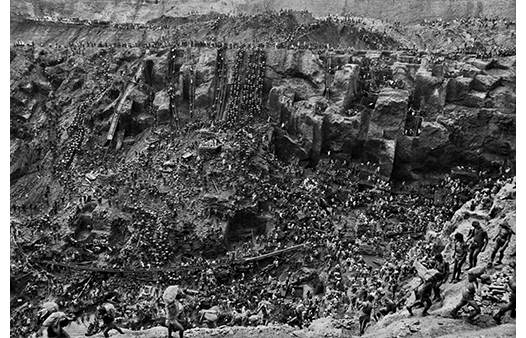
The rush was characterized by thousands of miners who flocked to the Serra Pelada mine in search of wealth and opportunity.
Discovery of the Nugget
In 1983, during the peak of the gold rush in Brazil, in the Serra Pelada region of Canaã dos Carajás, one of the largest gold nuggets ever discovered was unearthed. The discovery of the Serra Pelada Nugget was made by a group of "Garimpeiros", or artisanal miners, working in the Clay Banks. This mine, located in the state of Pará, Brazil, was one of the largest open-pit gold mines in the world at the time, with an estimated output of over 2 million ounces of gold per year. The discovery of the Canaa nugget caused a sensation across the globe, as it eclipsed the previous record holder, the "Welcome Stranger" nugget, which was discovered in 1869 in Moliagul, Victoria, Australia. The site was one of the largest and most productive open-pit gold mines in the world. The discovery of the Canaã Nugget offered a glimmer of hope and excitement for those working in the field, and it became a symbol of the potential riches hidden beneath the ground.
The Serra Pelada Nugget, with its massive size and impressive purity, served as a symbol of the potential riches that could be found in the gold-rich soils of Brazil.
Dimension & Size of the Nugget
This nugget, also known as the Serra Pelada Nugget, weighed an astounding 60.82 kg (134.2 lb) and measured roughly 15 cm x 28 cm x 11 cm (6 in x 11 in x 4 in), making it the largest gold nugget ever found.
The Serra Pelada Nugget's size and weight make it one of the most significant gold discoveries in history, particularly in relation to the other large gold nuggets found at the Serra Pelada mine. While the mine produced many large nuggets, most were in the range of a few grams to a few hundred grams. The Serra Pelada Nugget, in contrast, was a true monster - nearly ten times larger than any other nugget found there.
One interesting attribute of the Serra Pelada Nugget is its composition. Unlike many other large gold nuggets, which are often heavily eroded and contain significant impurities, the Serra Pelada Nugget was remarkably pure, with a gold content of over 95%.
The discovery of the Serra Pelada Nugget was part of a larger gold rush that took place in Brazil during the 1980s.
Current Location of Gold Nugget
The Pepita Canaã Nugget is currently on display in the Banco Central Museum in Brazil.
Today, the Serra Pelada mine is no longer in operation, and the area has been converted into a national park. However, the legacy of the Serra Pelada gold rush lives on, in the stories of the miners who risked everything in search of wealth, and in the remarkable treasures that they unearthed, such as the legendary Serra Pelada Nugget.
Normandy Nugget (1995)
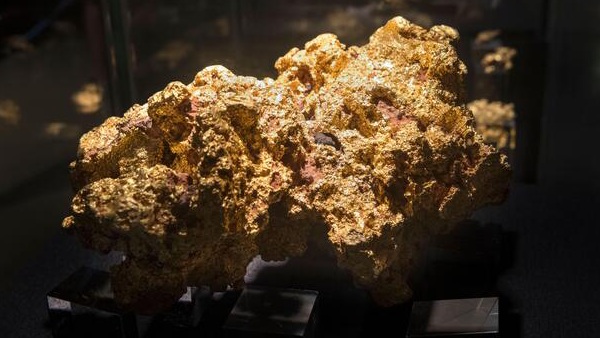
Discovery of the Nugget
The Normandy Nugget was discovered in 1995 in a dry creek bed near Kalgoorlie, Australia. It was discovered by a miner named Paul Jewell and earned its name from the Normandy Mining Company, which held ownership of the mine where it was found.
Kalgoorlie is renowned for being a gold-bearing region that has yielded numerous large gold nuggets over the years. The nugget was purchased by Normandy Mining in 2000. Normandy Mining has since been acquired by Newmont, a prominent mining company. The city has been a significant gold mining region since the late 1880s when gold was first discovered there. It is home to the Super Pit, one of Australia's largest open-cast gold mines.
Dimension & Size of the Nugget
The nugget weighs approximately 25.5 kilograms or 820 troy ounces and measures around 11 inches by 8 inches, making it worth more than 1.5 million USD today from the precious metal value alone.
Current Location of Gold Nugget
The Normandy Nugget is currently owned by the Newmont Mining Corporation. Over the years, it has been exhibited at various museums worldwide, including Tokyo and Colorado. Presently, it is on a long-term loan to the Perth Mint in Western Australia. The Perth Mint showcases an exceptional collection of large Australian gold nuggets, making it a must-visit for gold enthusiasts and visitors interested in precious metals. As part of a long-term agreement, the "Normandy Nugget" is currently on display at the Museum of the Perth Mint in Western Australia.
